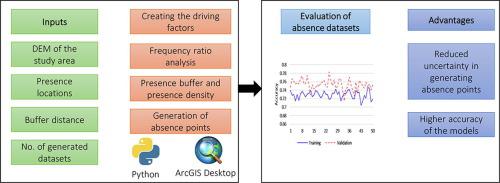Geoscience Frontiers ( IF 8.5 ) Pub Date : 2021-05-20 , DOI: 10.1016/j.gsf.2021.101232 Seyed Amir Naghibi , Hossein Hashemi , Biswajeet Pradhan

|
One important step in binary modeling of environmental problems is the generation of absence-datasets that are traditionally generated by random sampling and can undermine the quality of outputs. To solve this problem, this study develops the Absence Point Generation (APG) toolbox which is a Python-based ArcGIS toolbox for automated construction of absence-datasets for geospatial studies. The APG employs a frequency ratio analysis of four commonly used and important driving factors such as altitude, slope degree, topographic wetness index, and distance from rivers, and considers the presence locations buffer and density layers to define the low potential or susceptibility zones where absence-datasets are generated. To test the APG toolbox, we applied two benchmark algorithms of random forest (RF) and boosted regression trees (BRT) in a case study to investigate groundwater potential using three absence datasets i.e., the APG, random, and selection of absence samples (SAS) toolbox. The BRT-APG and RF-APG had the area under receiver operating curve (AUC) values of 0.947 and 0.942, while BRT and RF had weaker performances with the SAS and Random datasets. This effect resulted in AUC improvements for BRT and RF by 7.2, and 9.7% from the Random dataset, and AUC improvements for BRT and RF by 6.1, and 5.4% from the SAS dataset, respectively. The APG also impacted the importance of the input factors and the pattern of the groundwater potential maps, which proves the importance of absence points in environmental binary issues. The proposed APG toolbox could be easily applied in other environmental hazards such as landslides, floods, and gully erosion, and land subsidence.
中文翻译:

APG:一种新的基于 python 的 ArcGIS 工具箱,用于为地理空间研究生成缺失数据集
环境问题二进制建模的一个重要步骤是生成缺失数据集,这些数据集传统上是通过随机抽样生成的,可能会破坏输出的质量。为了解决这个问题,本研究开发了缺席点生成 (APG) 工具箱,这是一个基于 Python 的 ArcGIS 工具箱,用于自动构建地理空间研究的缺席数据集。APG 对海拔、坡度、地形湿度指数和与河流的距离等四个常用且重要的驱动因素进行频率比分析,并考虑存在位置缓冲层和密度层来定义不存在的低潜力或易感区- 生成数据集。要测试 APG 工具箱,我们在案例研究中应用了随机森林 (RF) 和增强回归树 (BRT) 的两种基准算法,以使用三个缺失数据集,即 APG、随机和缺失样本选择 (SAS) 工具箱来调查地下水潜力。BRT-APG 和 RF-APG 的接受者操作曲线下面积 (AUC) 值为 0.947 和 0.942,而 BRT 和 RF 在 SAS 和随机数据集上的表现较弱。这种效果导致 BRT 和 RF 的 AUC 提高了 7.2,从 Random 数据集提高了 9.7%,BRT 和 RF 的 AUC 提高了 6.1,从 SAS 数据集提高了 5.4%。APG 还影响了输入因素的重要性和地下水潜力图的模式,这证明了缺失点在环境二元问题中的重要性。











































 京公网安备 11010802027423号
京公网安备 11010802027423号